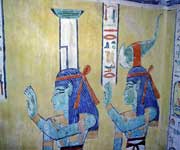Thebes, the city of the god Amon, was the capital of Egypt during the period of the Middle and New Kingdoms. With the temples and palaces at Karnak and Luxor, and the necropolises of the Valley of the Kings and the Valley of the Queens, Thebes is a striking testimony to Egyptian civilization at its height. Ancient Thebes with its Necropolis was inscribed as World Heritage Site in 1979. Thebes contains the finest relics of the history, art and religion of ancient Egypt, of which it was the capital in its period of greatest splendour.

Continent: Africa
Country: Egypt
Category: Cultural
Criterion: (I) (III)(VI)
Date of Inscription: 1979
Fabulous site of Luxor and Karnak
Hundreds of sovereigns, from pharaohs to Roman emperors, glorified the city with architecture, obelisks and sculpture. The exaltation of life found expression in the Thebes of the Living, identifiable in the fabulous site of Luxor and Karnak, on the right bank of the Nile, the site of the temples dedicated to the divine triad of Montu, Amon and Mut, while the celebration of death took shape in the Thebes of the Dead.
 |
| The Ancient Egyptian Art |









No comments:
Post a Comment